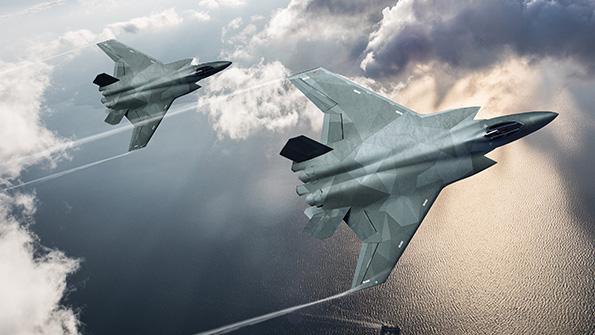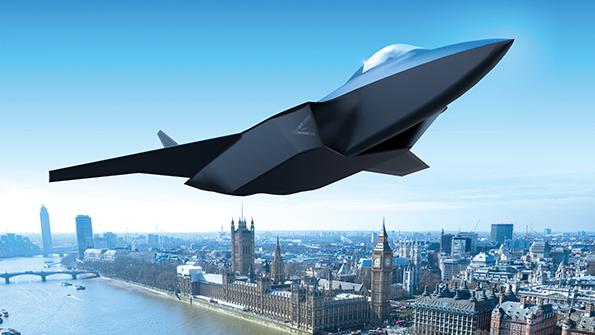
Industry partners face tight timelines if they are to deliver the Global Combat Aircraft Program fighter aircraft by 2035.
Here in the UK, people have long memories when it comes to politics and aircraft projects.
The British Aircraft Corp.’s TSR.2 was a sleek, supersonic nuclear strike aircraft (see photo below) that arguably was born ahead of its time in the 1960s. But its development coincided with great leaps in missile technology, a change in government and an option to buy off-the-shelf General Dynamics F-111s from the U.S.
- BAE-Leonardo-Mitsubishi GCAP joint venture is expected to form this year
- Exports are a key focus as the GCAP will likely be the first mover in the sixth-generation fighter market
- The UK’s EJ200-powered demonstrator aircraft first flight is anticipated in 2027
Canceled in 1965 by a new Labour government, the TSR.2 fell victim to rising costs, interservice squabbling and the expectation that buying American would be cheaper.
Sixty years on, the UK is on the verge of launching development of another new advanced combat aircraft—this time with Italy and Japan—and historic parallels are emerging.
Key decisions in the Global Combat Air Program’s (GCAP) development will be made by a Labour-led government formed in 2024. It is being undertaken during a time of extraordinary technological change—particularly in uncrewed aircraft systems—and again an option remains to acquire an off-the-shelf platform in the form of Lockheed Martin’s F-35 Joint Strike Fighter.
It is perhaps no wonder that reports on the TSR.2’s development and ultimate downfall are required reading for senior leaders in the GCAP initiative as they gear up for political decisions that will assure them of work for decades.

By this time next year, the governments in London, Rome and Tokyo are expected to have delivered a contract for the full development of the crewed fighter at the heart of the GCAP, a platform that is being planned to replace British and Italian Eurofighters and Japanese Mitsubishi F-2s. The three countries also hope to secure a portion of the export market.
Timelines are tight. Japan wants the aircraft ready for initial front-line service in 2035, and 10 years is not much time to deliver a clean-sheet, low-observable combat aircraft with new engines, advanced sensors and avionics—as well as to fly prototypes, perform testing and set up a support structure. But this is the task the nations have set themselves by targeting development in half the time taken for the Eurofighter program.
To be ready, companies in the three countries have spent billions of dollars and worked for years on technology maturation nationally, bilaterally and trilaterally. Japan has flown a demonstrator, the Mitsubishi X-2 Advanced Technology Demonstrator-X, while the UK plans to fly another in 2027. There also will be a Boeing 757 flying testbed operating in support of Leonardo UK’s sensor development efforts.
Over the past year, industry partners have been working to nail down aspects of work allocation, and in the coming months the national primes—the UK’s BAE Systems, Italy’s Leonardo and Japan’s Mitsubishi Heavy Industries—are expected to form a joint venture. It would be like Eurofighter GmbH, the company that manages the fighter program on behalf of industry partners. That new joint venture will lead the GCAP industrially and receive the development contract from the UK, Italy and Japan.
Separately, to manage the program, the three governments have formed the GCAP International Government Organization (GIGO), a UK-based entity with rotational management that will operate similarly to the U.S. F-35 Joint Program Office. GIGO’s role will include awarding contracts for the different phases, defining and prioritizing requirements, and resolving issues among the partners.
“When I first started this job, I was told it would take 3-5 years to get a treaty in place to set up a delivery structure,” Richard Berthon, director of Future Combat Air at the UK Defense Ministry, told the Parliamentary Defense Select Committee in February. “But we have had the signature within one year from the initial partnering agreement. . . . That is testament to some extraordinary work between the three countries.”
Key goals for the program are freedom of action and modification, with which the three partner nations have struggled through their acquisition of the F-35, particularly in the slow pace of adding new weaponry.
“GCAP is not trying to do the same thing as F-35,” Royal Air Force Chief of Staff Air Chief Marshal Richard Knighton says. “It’s very deliberately being designed to complement and enhance the capabilities of our F-35s, to provide a different suite of capabilities for the partners and to make the most of the benefits that come with a sovereign capability.”

While work has moved swiftly so far, efforts still could be challenged by the state of finances in any of the three countries, especially the UK, where the government financial workings are not configured for multiyear projects like that proposed for the GCAP. Industry fears that the GCAP could be slowed by the stop-and-start approach experienced when previous programs entered different phases, adding risk to the timeline.
Like with the European Future Combat Air System (FCAS), disagreements could occur around workshare. Leonardo CEO Roberto Cingolani has spoken openly to Japanese media in recent months about the need for equal partnership in terms of workshare, but Italy has yet to share information publicly about investments it has made in technology maturation. Obvious areas for Italy’s involvement include the infrared search-and-track and electronic warfare systems.
Questions also remain about other countries’ participation in the program, as well as exports. Saudi Arabia’s interest has long been known. Some officials close to the Eurofighter program have suggested a Saudi purchase would be linked to whether the country can gain accession into the GCAP. Royal Saudi Air Force Maj. Gen. Hamed Alamri, director of the country’s Joint Chiefs of Staff and chairman of the air force’s Committee on Future Capabilities, said at a Royal Aeronautical Society event in May that Riyadh aims to be “an equal partner” in any sixth-generation fighter program. “Saudi Arabia seeks to become a global innovator, not just a customer,” he noted.
The UK and Saudi Arabia had been working on a yearlong study announced in early 2023 to explore the future for a combat air relationship and the potential creation of a Future Combat Air Partnership. Adding a fourth country to the GCAP such as Saudi Arabia would bring formidable financial resources but could require a costly and time-consuming unraveling of the existing agreement, bringing delays to the already tight timelines.
In terms of exports, the partner nations are hoping to secure a first-mover advantage in the sixth-generation combat aircraft market. After all, the timeline for the European FCAS is at least five years behind that of the GCAP. And the U.S. probably will not want to export the platform that emerges from its Next-Generation Air Dominance program.
A first-mover advantage also will be essential for the countries to spread out the cost of development, as they are unlikely to purchase more than a few hundred aircraft among them. Currently, the GCAP lacks the mass and economies of scale associated with the number of F-35s on order.
A particular challenge is that Japan has strict rules on defense exports, and the country’s involvement in the GCAP has prompted discussions among ruling parties that have agreed to revise export restrictions. Exports might be limited to countries that have signed defense equipment and technology transfer deals with Japan, media reports have suggested.
During the Farnborough Airshow, the focus is likely to be on the technology maturation work and development of the UK demonstrator aircraft, projects announced at the 2022 show.
BAE has provided an update on progress of development of flight-control software, ejection-seat testing and aerodynamic engine trials to develop a serpentine duct that will allow the aircraft’s two Eurojet EJ200s to operate across the demonstrator’s flight envelope. The company is expected to announce further progress on the platform’s development and likely the aircraft’s planform.
Similar to the Experimental Aircraft Program demonstrator that supported development of the Eurofighter, the UK Tempest demonstrator is expected to prove “high-risk elements,” including low-observable materials and technologies envisioned for the airframe. The fighter is also planned to launch missiles from its internal weapon bay at supersonic speeds, something never done by UK industry before.
The last UK-built aircraft with a bomb bay was the Blackburn Buccaneer, which first flew in the late 1950s but only dropped bombs flying at subsonic speeds.
The first flight of the Tempest demonstrator is planned for 2027.





